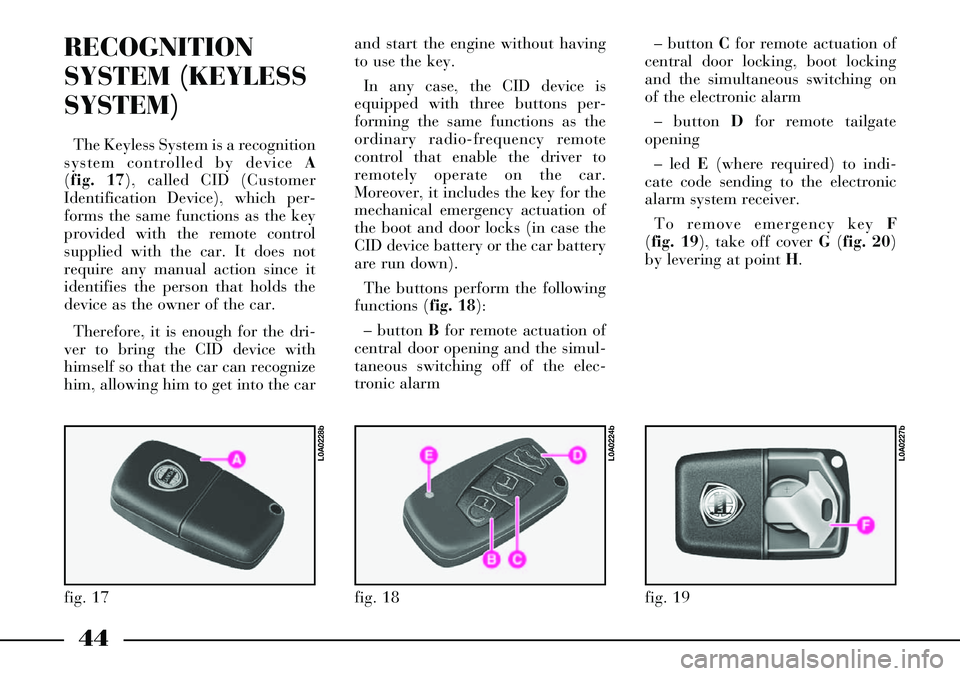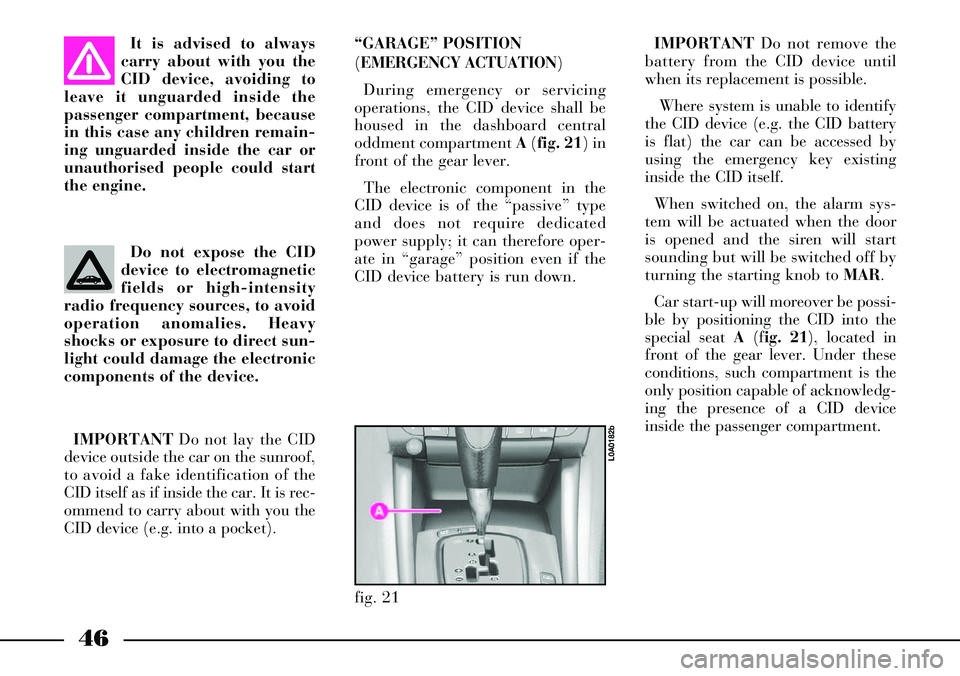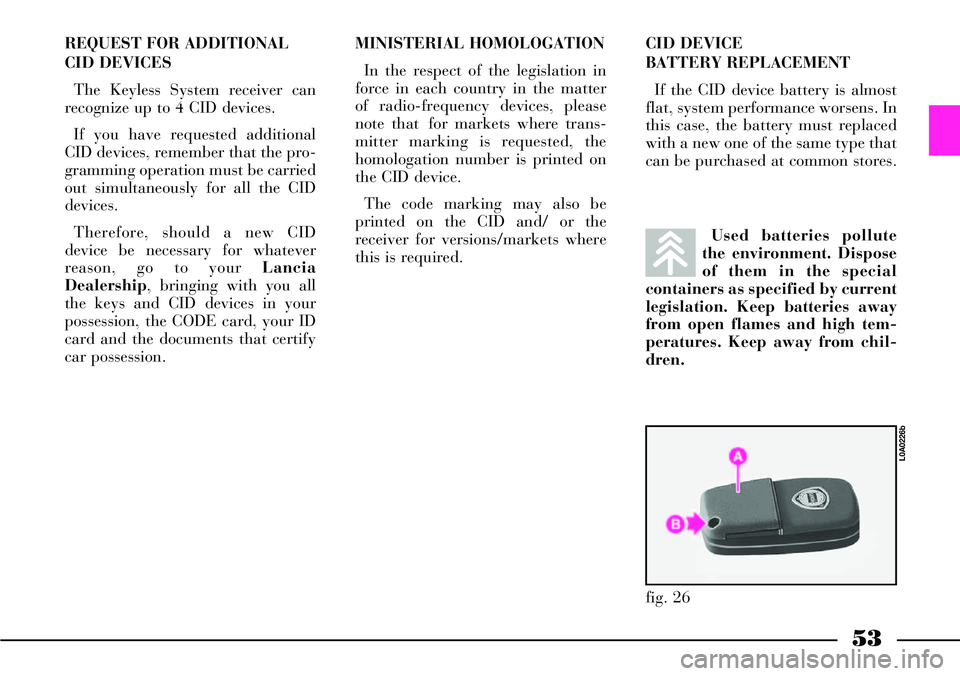radio Lancia Thesis 2007 Owner handbook (in English)
[x] Cancel search | Manufacturer: LANCIA, Model Year: 2007, Model line: Thesis, Model: Lancia Thesis 2007Pages: 386, PDF Size: 8.69 MB
Page 45 of 386

44
RECOGNITION
SYSTEM (KEYLESS
SYSTEM)
The Keyless System is a recognition
system controlled by device A
(fig. 17), called CID (Customer
Identification Device), which per-
forms the same functions as the key
provided with the remote control
supplied with the car. It does not
require any manual action since it
identifies the person that holds the
device as the owner of the car.
Therefore, it is enough for the dri-
ver to bring the CID device with
himself so that the car can recognize
him, allowing him to get into the carand start the engine without having
to use the key.
In any case, the CID device is
equipped with three buttons per-
forming the same functions as the
ordinary radio-frequency remote
control that enable the driver to
remotely operate on the car.
Moreover, it includes the key for the
mechanical emergency actuation of
the boot and door locks (in case the
CID device battery or the car battery
are run down).
The buttons perform the following
functions (fig. 18):
– button Bfor remote actuation of
central door opening and the simul-
taneous switching off of the elec-
tronic alarm– button Cfor remote actuation of
central door locking, boot locking
and the simultaneous switching on
of the electronic alarm
– button Dfor remote tailgate
opening
– led E(where required) to indi-
cate code sending to the electronic
alarm system receiver.
To remove emergency keyF
(fig. 19), take off cover G(fig. 20)
by levering at point H.
fig. 17
L0A0228b
fig. 18
L0A0224b
fig. 19
L0A0227b
Page 47 of 386

46
IMPORTANTDo not remove the
battery from the CID device until
when its replacement is possible.
Where system is unable to identify
the CID device (e.g. the CID battery
is flat) the car can be accessed by
using the emergency key existing
inside the CID itself.
When switched on, the alarm sys-
tem will be actuated when the door
is opened and the siren will start
sounding but will be switched off by
turning the starting knob to MAR.
Car start-up will moreover be possi-
ble by positioning the CID into the
special seat A(fig. 21), located in
front of the gear lever. Under these
conditions, such compartment is the
only position capable of acknowledg-
ing the presence of a CID device
inside the passenger compartment.
fig. 21
L0A0182b
It is advised to always
carry about with you the
CID device, avoiding to
leave it unguarded inside the
passenger compartment, because
in this case any children remain-
ing unguarded inside the car or
unauthorised people could start
the engine.
Do not expose the CID
device to electromagnetic
fields or high-intensity
radio frequency sources, to avoid
operation anomalies. Heavy
shocks or exposure to direct sun-
light could damage the electronic
components of the device.
IMPORTANTDo not lay the CID
device outside the car on the sunroof,
to avoid a fake identification of the
CID itself as if inside the car. It is rec-
ommend to carry about with you the
CID device (e.g. into a pocket). “GARAGE” POSITION
(EMERGENCY ACTUATION)
During emergency or servicing
operations, the CID device shall be
housed in the dashboard central
oddment compartment A(fig. 21) in
front of the gear lever.
The electronic component in the
CID device is of the “passive” type
and does not require dedicated
power supply; it can therefore oper-
ate in “garage” position even if the
CID device battery is run down.
Page 54 of 386

53
REQUEST FOR ADDITIONAL
CID DEVICES
The Keyless System receiver can
recognize up to 4 CID devices.
If you have requested additional
CID devices, remember that the pro-
gramming operation must be carried
out simultaneously for all the CID
devices.
Therefore, should a new CID
device be necessary for whatever
reason, go to your Lancia
Dealership, bringing with you all
the keys and CID devices in your
possession, the CODE card, your ID
card and the documents that certify
car possession.MINISTERIAL HOMOLOGATION
In the respect of the legislation in
force in each country in the matter
of radio-frequency devices, please
note that for markets where trans-
mitter marking is requested, the
homologation number is printed on
the CID device.
The code marking may also be
printed on the CID and/ or the
receiver for versions/markets where
this is required.Used batteries pollute
the environment. Dispose
of them in the special
containers as specified by current
legislation. Keep batteries away
from open flames and high tem-
peratures. Keep away from chil-
dren.
fig. 26
L0A0226b
CID DEVICE
BATTERY REPLACEMENT
If the CID device battery is almost
flat, system performance worsens. In
this case, the battery must replaced
with a new one of the same type that
can be purchased at common stores.
Page 171 of 386

170
CONTROLS
HAZARD LIGHTS (fig. 124)
These come on when switch Ais
pressed, regardless of the position of
the ignition key.
When these lights are on, the switch
and the direction indicator warning
lights on the instrument panel flash.
Press the switch again to turn the
lights off.
IMPORTANTThe use of hazard
lights is governed by the traffic regu-
lations of the country where the car is
being driven. These laws should be
complied with.
fig. 124
L0A0103b
Maximum heat power
Reduced heat power
Rated voltage
Operating current
Idle current
Operating voltage
Operating temperature
Fuel consumption
Weight
Noiseabout 5 kW
about 2,5 kW
12 V
45W to 13.5V; 34W to 12V
1mA (5mA with radio receiver)
10,25V ± 0,25V ÷ 15,50V ± 0,25V
- 40º C ± 2K to 70º C ± 2K
with reduced power 0,25 Kg/h
with maximum power 0,5 Kg/h
2,9 Kg
51 db.
TECHNICAL SPECIFICATIONS
Page 223 of 386

222
SOLAR CELL
OPERATED
SUNROOF
The sunroof is electrically con-
trolled and its operation is possible
only with the ignition key at MAR.
The sunroof can slide lenghtwise,
with various opening positions, until
it fully retracts into the special hous-
ing, or can lift at the front (by pivot-
ing) to allow passenger compart-
ment aeration.
The upper part of the sunroof
incorporates a set of solar cells that
feed the climate control system fan
at first speed when the car is parked
to reduce the temperature inside the
passenger compartment.IMPORTANTBest operation of
the fan when the car is parked is
obtained by closing completely the
windows and sunroof. Furthermore,
to check operation at first speed of
the fan, disengage air vents and set
air distribution from central dash-
board vents only before leaving the
car.
The sunroof is equipped with an
anti-trap safety system, which con-
trols the closing lenghtwise sliding as
well as pivoting.
The electronic control unit that
controls the system is able to detect
the presence of obstacles when the
roof is closing or pivoting at the rear;
in this case, the system will interrupt
the sunroof travel and immediately
reverse it for a short stretch. RADIO TRANSMITTERS AND
CELLULAR TELEPHONES
Radio transceiver equipment (e.g.:
e-tacs mobile phones, HAM radio
systems and the like) shall not be
used inside the car unless a separate
aerial is mounted outside the car.
The use of these devices inside the
passenger compartment (without
external aerial) may cause electrical
systems equipping the car to mal-
function. This could compromise car
safety in addition to constituting a
potential hazard for the passengers.
In addition, transmission and
reception of these devices may be
affected by the shielding effect of the
car body.
As concerns the use of mobile
phones (GSM, GPRS, UMTS) pro-
vided with official EC approval,
strictly comply with the instructions
given by the mobile phone manufac-
turer.
Page 249 of 386

248
fig. 224
L0A213b
SOUND SYSTEM
The car is equipped with a com-
plete sound system, consisting of the
following:
– RDS-TMC radio integral with the
CONNECT system
– audio CD/navigation CD-ROM
player A(fig. 221) on the dashboard
– audio cassette player Bon the
dashboard– multiple compact disc player
(CD-changer) C(fig. 222) in the
glove compartment (where fitted)
– BOSE HI-FI system (where fit-
ted).
For detailed instructions on the
Radio, CD and CD-Changer, refer to
the CONNECT supplement provid-
ed with the car.
SPEAKERS
Front speakers (fig. 223)
The front speakers Aare housed in
front door panels.Rear speakers (fig. 224)
The rear speakers Bare housed in
the rear door panels.
fig. 221
L0A0210b
fig. 222
L0A0217b
fig. 223
L0A0215b